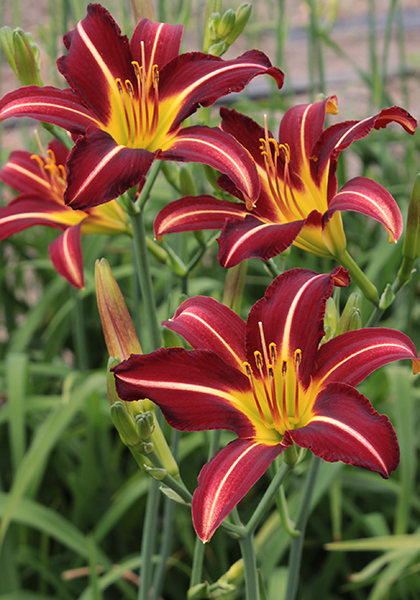|
|

 
|
|
The “rich, lustrous, velvety black cherry color” of this old daylily (in the words of the 1949 Schreiner’s catalog) would be great no matter what, but it’s the creamy white line down the center of each petal that makes it so striking and unforgettable. You’ll find yourself drawn to it from across the garden – and looking forward to it every summer. 34-36”, mid-season, dormant, 2 fans, zones 4a-8a(10aWC), from our own micro-farm. |
|
ZONES 4a-8a(10aWC) HEIGHT 34-36” SOURCE America, Michigan, Ann Arbor LIGHT full sun, half sun, dappled, light shade |
PLANTING & CAREPlant these bare-root perennials as soon as possible in the spring. They’re eager to grow, can take light frost, and need water and sunlight to stay healthy. If necessary, store in a plastic bag in the refrigerator for a few days or “heel in” briefly in moist sand or soil in a shady spot. Daylilies like lots of sun but most bloom well in light shade, too, and often prefer it in the South. Loamy, well-drained soil suits them best, but they’re adaptable and should do fine in any soil that’s not too wet or dry. Plant 18-24 inches apart (to leave growing room for future years) with the crown (where the foliage meets the roots) no more than one inch below the soil surface. Dig a hole big enough to fit the roots comfortably, mound soil in the center, set the plant on top, and spread the roots out down the sides of the mound. Fill in and firm soil around roots, making sure the crown ends up no more than one inch deep. Water well. Water regularly, especially the first year and from spring till flowering in future years. First-year plants usually bloom sparsely — if at all — concentrating instead on developing a strong root system. Deadhead (remove) spent blooms daily for a neater look and, to increase bloom the following year, remove any seedpods that may form. After bloom, normal senescence (aging) may cause foliage to subside, yellow, or turn brown at the tips. If this bothers you, feel free to trim it a bit or even cut the foliage to the ground completely — though not the first year! With good care, fresh new foliage will emerge. Daylilies are hardy perennials and winter protection is rarely needed. In spring, remove dead foliage, fertilize if indicated by a soil test, and resume watering. For more information, including tips on the few pests and diseases that occasionally trouble daylilies, see the “Frequently Asked Questions” section of the excellent American Hemerocallis Society website. Learn more about growing and enjoying daylilies at our Daylilies Newsletter Archives. |

|
SPRING
|
· |
SUMMER
|
· |
FALL
|
· |
LEARN MORE
|
· |
ORDERING
|

|










